Rivian Bundle
Who are Rivian's Ideal Customers?
In the ever-evolving Rivian SWOT Analysis, understanding the "who" behind the wheel of an electric adventure vehicle is crucial for its future. As the electric vehicle market heats up, Rivian's success hinges on pinpointing its ideal customer. This deep dive explores the specifics of Rivian's customer demographics and target market, providing critical insights for investors and strategists alike.
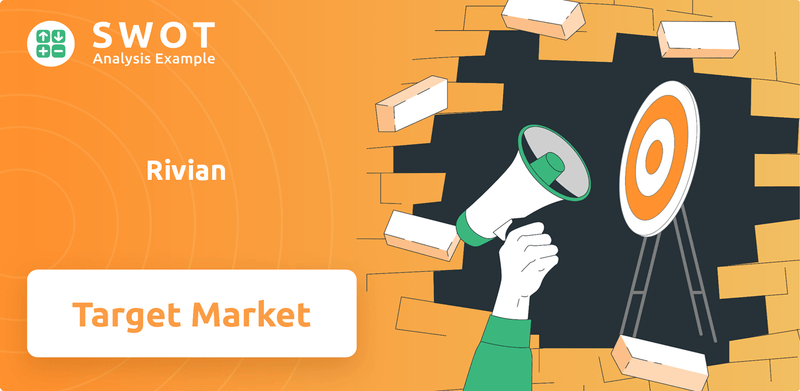
This analysis of Rivian's customer base examines key factors like age, income, location, and lifestyle to create a comprehensive Rivian target audience profile. By understanding the nuances of Rivian customer demographics, we can better grasp Rivian buyers' motivations and predict future trends in the electric vehicle market. This knowledge is essential for anyone looking to understand Rivian market analysis and the company's strategic positioning.
Who Are Rivian’s Main Customers?
Understanding the Rivian customer demographics is key to grasping the company's market strategy. The primary focus is on two main segments: consumers (B2C) and businesses (B2B). Rivian's initial success has been with consumers, particularly those seeking adventure and sustainability.
The consumer segment for Rivian's R1T pickup and R1S SUV leans towards affluent individuals. The high price points, starting around $70,000 and $78,000 respectively, and potentially reaching $100,000 with upgrades, indicate a customer base with significant disposable income. These buyers are often active, potentially family-oriented, and value both innovation and environmental responsibility.
The B2B segment is largely driven by the partnership with Amazon, with over 20,000 commercial vans on the road as of 2024. Rivian is expanding its B2B opportunities by opening its commercial vans to all commercial users after the expiration of its exclusive deal with Amazon. This segment targets businesses looking for sustainable and efficient fleet solutions.
This group values outdoor activities, sustainability, and innovative technology. They are willing to pay a premium for vehicles that align with their lifestyle. These Rivian buyers are likely to be early adopters of electric vehicle technology.
Businesses looking to reduce their carbon footprint and operating costs. The Rivian target market includes companies that require efficient and environmentally friendly delivery solutions. The expansion of the B2B segment opens doors to various commercial applications.
Rivian aims to broaden its customer base with the introduction of the R2, R3, and R3X models. The R2 SUV, anticipated to be priced around $45,000, is designed to tap into the mid-sized SUV market. This move is intended to convert internal combustion engine (ICE) customers to EVs and increase sales volume.
The partnership with Amazon has been a key driver for Rivian's B2B success. As of 2024, Amazon's Rivian vans have delivered over 1 billion packages in the United States. This collaboration provides a significant revenue stream and validates Rivian's technology in the commercial sector.
The Rivian customer demographics are evolving as the company expands its product line. Understanding the EV consumer profiles is crucial for tailoring marketing and sales strategies. The company's focus on adventure, sustainability, and innovation appeals to a specific segment of the market.
- Income Levels: Primarily targeting affluent consumers with disposable income.
- Lifestyle: Active, outdoor-oriented, and environmentally conscious.
- Geographic Location: Initially focused on areas with high EV adoption rates and outdoor recreational opportunities.
- Future Growth: Expanding into the mid-sized SUV market to reach a broader audience.
Rivian SWOT Analysis
- Complete SWOT Breakdown
- Fully Customizable
- Editable in Excel & Word
- Professional Formatting
- Investor-Ready Format
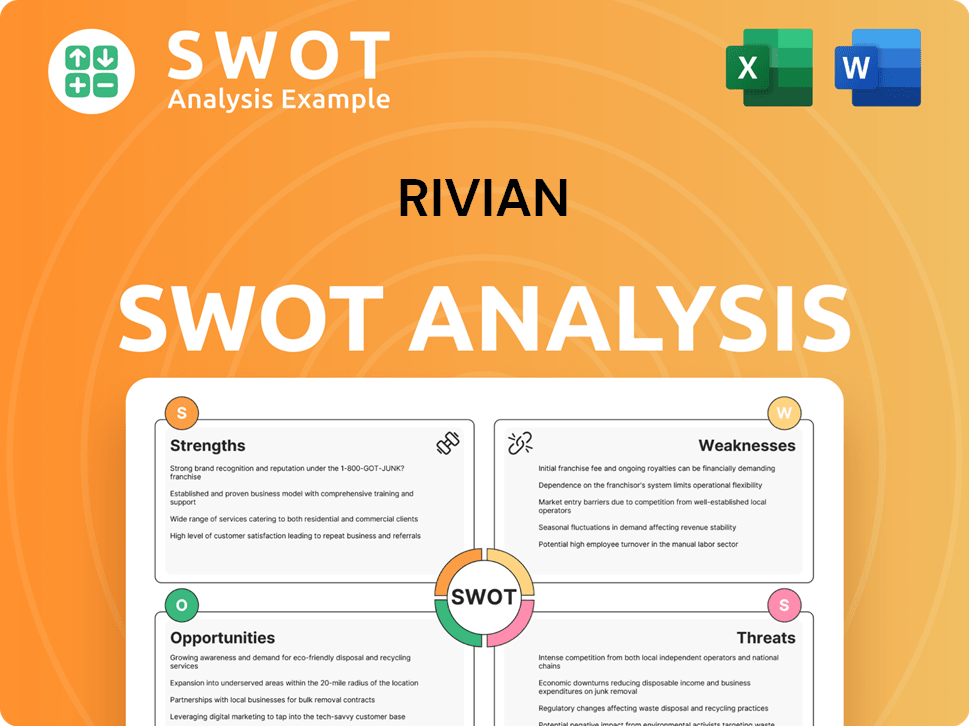
What Do Rivian’s Customers Want?
Understanding the needs and preferences of the Rivian customer is crucial for effective market positioning. The company's target audience is drawn to a unique combination of factors, including performance, technology, and environmental consciousness. This analysis delves into the key drivers behind their purchasing decisions and the aspects of the vehicles that resonate most with them.
Rivian's customers are not just looking for a mode of transportation; they are seeking an experience that aligns with their values and lifestyle. This includes a desire for adventure, a connection to the outdoors, and a commitment to sustainability. The company's vehicles are designed to cater to these aspirations, offering features that enhance the overall ownership experience.
The Marketing Strategy of Rivian focuses on attracting customers who value innovation and are willing to embrace new technologies. These customers appreciate the blend of rugged capability and eco-friendly design that Rivian offers, making it a compelling choice in the electric vehicle market.
Rivian buyers prioritize vehicles with robust performance, especially off-road capabilities. The R1T and R1S models are designed to handle diverse terrains, appealing to those who enjoy outdoor activities.
Vehicle range is a critical factor, with customers expecting substantial distances on a single charge. Fast charging capabilities are also essential, with the ability to add up to 200-300 miles in approximately 30 minutes.
Advanced technology, including driver-assistance systems and over-the-air software updates, is a key expectation. Integrated digital features enhance the overall user experience.
A strong desire to reduce their environmental footprint drives many Rivian buyers. Features like vegan leather interiors and the use of recycled materials resonate with this group.
The vehicles appeal to those who seek adventure and a connection to the outdoors. Rivian's design and marketing often emphasize this lifestyle element.
Customers want an integrated and user-friendly electric vehicle experience. This includes easy access to charging networks and intuitive vehicle controls.
Rivian addresses customer needs by offering versatile vehicles suitable for various terrains and providing ample storage. The company continuously updates its software based on customer feedback. The upcoming R2, R3, and R3X models, expected to be priced under $50,000, demonstrate Rivian's adaptation to market demands for more affordable EVs.
- Versatile Vehicles: Designed to handle diverse terrains and offer ample storage for outdoor gear.
- Continuous Software Updates: Enhancements based on customer feedback, including launch mode and improved voice control.
- Strategic Partnerships: Collaborations with outdoor adventure brands to provide exclusive packages and accessories.
- Affordability: The R2, R3, and R3X models are expected to debut for under $50,000, addressing affordability concerns.
Rivian PESTLE Analysis
- Covers All 6 PESTLE Categories
- No Research Needed – Save Hours of Work
- Built by Experts, Trusted by Consultants
- Instant Download, Ready to Use
- 100% Editable, Fully Customizable
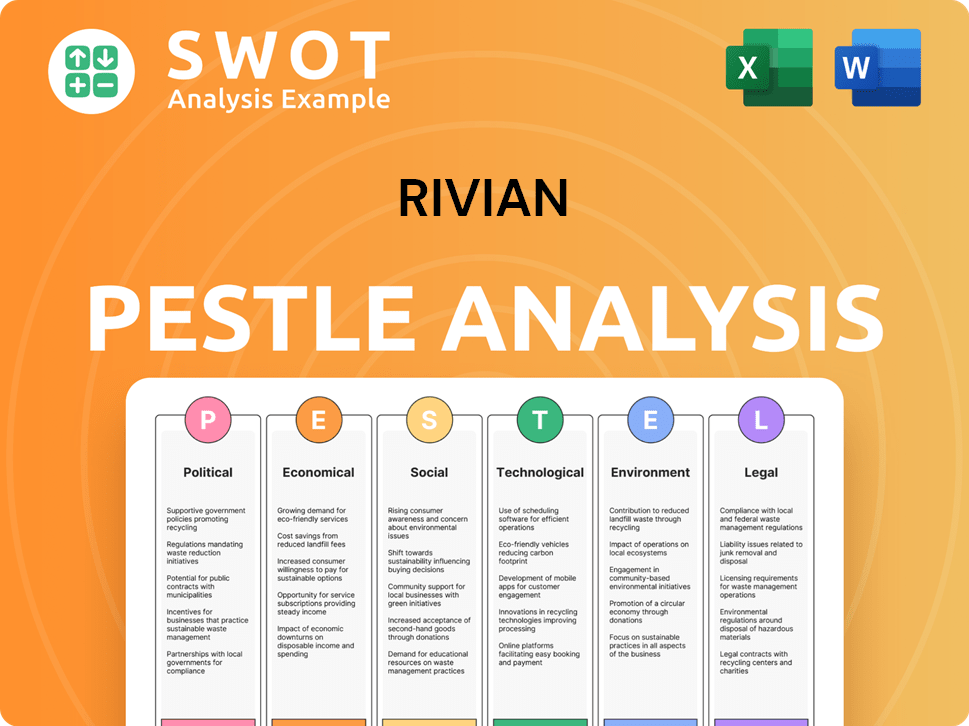
Where does Rivian operate?
The geographical market presence of Rivian is primarily focused on North America, with a strong emphasis on the United States and an expanding presence in Canada. As of January 2024, the company has established a network of retail locations across major metropolitan areas within the U.S., including flagship experience centers in cities like Los Angeles, San Francisco, Chicago, and New York. This strategic placement aims to capture a significant portion of the Rivian owners demographic.
Rivian's distribution strategy currently covers 45 states, offering direct sales and service capabilities to a wide range of customers. While specific market share data by city or region is not readily available, Los Angeles has historically been one of Rivian's largest markets, indicating a strong consumer base in that area. The company's focus on expanding its service infrastructure and enhancing its mobile service capabilities further supports its commitment to the North American market.
In Q1 2025, Rivian held a U.S. market share of EVs at 2.9%, a decrease from its peak of 5.0% in Q3 2023. This shift highlights the increasing competition within the electric vehicle market, as traditional automakers introduce more EV models. Rivian is actively working to expand its service network, aiming to increase its 77 North American service centers to 100 soon, with a goal of handling 70% of service issues through mobile service.
Rivian's primary focus is on the U.S. market, with a growing presence in Canada. This strategic focus enables the company to concentrate its resources on a specific geographic region, optimizing its marketing and distribution efforts.
The company operates 24 retail locations across major U.S. metropolitan areas, including experience centers in key cities. Rivian is expanding its service infrastructure to enhance customer support and convenience, with plans to increase service centers and mobile service capabilities.
Rivian's U.S. market share in the EV sector was 2.9% in Q1 2025. The company faces growing competition from established automakers increasing their EV offerings. Rivian is responding by focusing on customer service and expanding its service network.
The R2 SUV is designed for global market expansion, with Europe being a primary target. This signals a strategic move to adapt its offerings and marketing to succeed in diverse international markets.
Rivian is exploring advancements in autonomous driving technology, which could influence its global market strategies. This technology could enhance the appeal of its vehicles and expand its market reach.
Rivian Business Model Canvas
- Complete 9-Block Business Model Canvas
- Effortlessly Communicate Your Business Strategy
- Investor-Ready BMC Format
- 100% Editable and Customizable
- Clear and Structured Layout
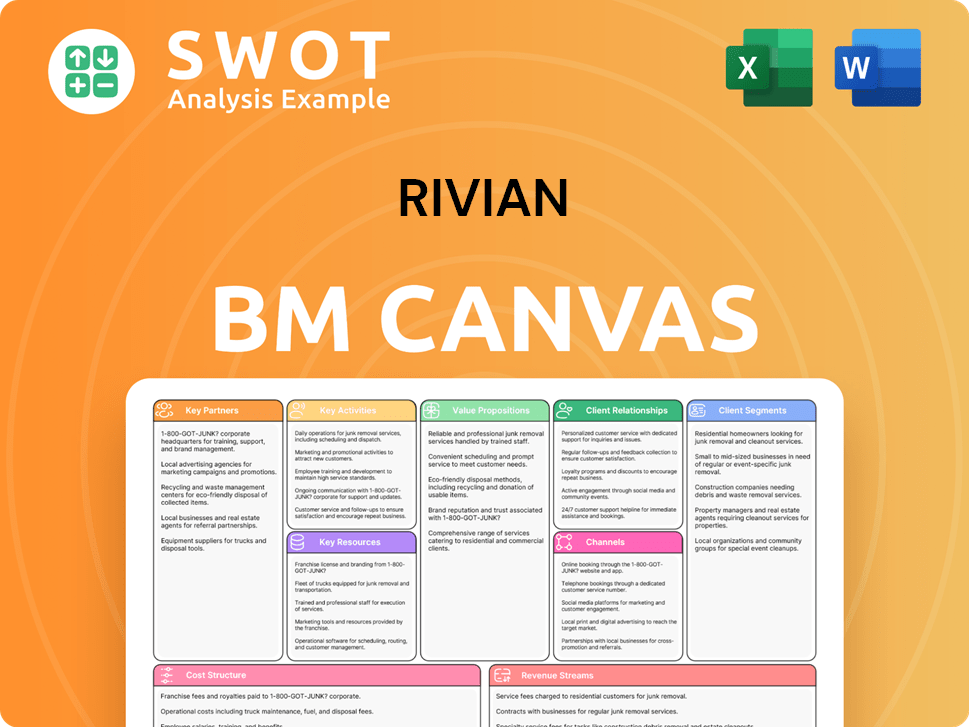
How Does Rivian Win & Keep Customers?
Understanding the strategies employed by a company is crucial for assessing its long-term viability. This chapter delves into the customer acquisition and retention strategies of the company, exploring how it attracts and keeps its customer base engaged. The company's approach combines direct sales, brand building, and loyalty programs to foster a strong connection with its customers.
The company's marketing efforts are centered around a direct-to-consumer model, complemented by a strong emphasis on brand identity. The company leverages digital media, social platforms, and industry events to reach its target audience. Furthermore, the company is investing in after-sales service, aiming to provide a comprehensive ownership experience that enhances customer satisfaction and encourages repeat business.
The company's strategy is designed to appeal to a broad audience while maintaining a focus on the unique aspects of its brand. The company aims to increase brand awareness as it targets selling hundreds of thousands of vehicles annually in the coming years, a significant jump from its current sales of around 50,000-60,000 vehicles per year.
The company utilizes a direct online sales approach via its official website. Customers can configure their orders digitally, with a $1,000 refundable reservation deposit. This streamlined process simplifies the buying experience, making it more accessible for potential buyers.
Company-owned retail stores play a vital role in educating customers and fostering engagement. These spaces provide opportunities for potential buyers to learn about the products and interact with the brand. This approach supports the Rivian customer demographics by offering a tangible experience.
The company launched its first full-fledged brand campaign, 'Real Rivian Adventures,' which transforms real owner stories into advertisements. This campaign appears on CTV, YouTube, and potentially broadcast TV. This strategy aims to create mass-market appeal and increase brand awareness.
The company has implemented customer loyalty programs and referral incentives. The 'Rivian Rewards' referral program, launched in August 2024, offers both referrers and new buyers 750 reward points. These points can be used for Gear Shop purchases or future vehicle purchases.
The company’s commitment to after-sales service is a key element in its retention strategy. The company plans to open more service centers in 2025 and aims for mobile service to handle 70% of service issues. This focus on convenience and responsiveness is designed to enhance customer satisfaction and build long-term loyalty, which is crucial for the Rivian target market. The company's investment in its proprietary technology stack, including its electric powertrain and battery systems, aims to enhance vehicle performance and the overall ownership journey. This comprehensive approach, including services like home charging installation, mobile service, and financing, contributes to a positive ownership experience.
Launched in August 2024, this program offers 750 reward points to both the referrer and the new buyer. Points are redeemable for Gear Shop purchases or future vehicle purchases, equivalent to $1 per point. The program also provides 6 months of free charging at Rivian Adventure Networks.
In October 2024, a loyalty discount was introduced, offering current Gen 1 R1 owners a $3,500 discount on the purchase or lease of a new 2025 R1 Dual Large, Dual Max, or Tri Max when trading in their eligible vehicle. This initiative encourages repeat purchases and customer loyalty.
The company plans to open additional service centers in 2025 to improve service accessibility. The company aims to handle 70% of service issues through mobile service, enhancing convenience for customers. This expansion is critical for supporting the growing Rivian buyers base.
The company offers home charging installation services, providing convenience for owners. Mobile service options are also available, reducing the need for customers to visit service centers. These services improve the overall ownership experience.
The company offers Connect+, a subscription-based streaming and connectivity service. Future plans include Rivian Autonomy Platform+, expanding the range of services available to customers. These features enhance the vehicle's value and appeal.
The company's investment in its proprietary technology stack, including electric powertrains and battery systems, enhances vehicle performance. Advancements in autonomous driving technology are also a key focus, contributing to an integrated ownership experience.
The company focuses on a direct-to-consumer model, online sales, and company-owned retail stores for customer engagement. Loyalty programs, such as the Rivian Rewards program, and referral incentives are utilized for customer retention. After-sales service enhancements, including more service centers and mobile service, are key to customer satisfaction. The company also emphasizes proprietary technology and connected services to enhance the ownership experience.
- Direct Sales Model
- Loyalty Programs
- Service Enhancements
- Technology Integration
For a deeper dive into the company's strategic approach, particularly its growth strategies, consider exploring the insights provided in Growth Strategy of Rivian. The company's focus on direct sales, brand building, and customer retention is critical in the competitive electric vehicle market, and its initiatives are designed to appeal to a specific segment of the EV consumer profiles.
Rivian Porter's Five Forces Analysis
- Covers All 5 Competitive Forces in Detail
- Structured for Consultants, Students, and Founders
- 100% Editable in Microsoft Word & Excel
- Instant Digital Download – Use Immediately
- Compatible with Mac & PC – Fully Unlocked
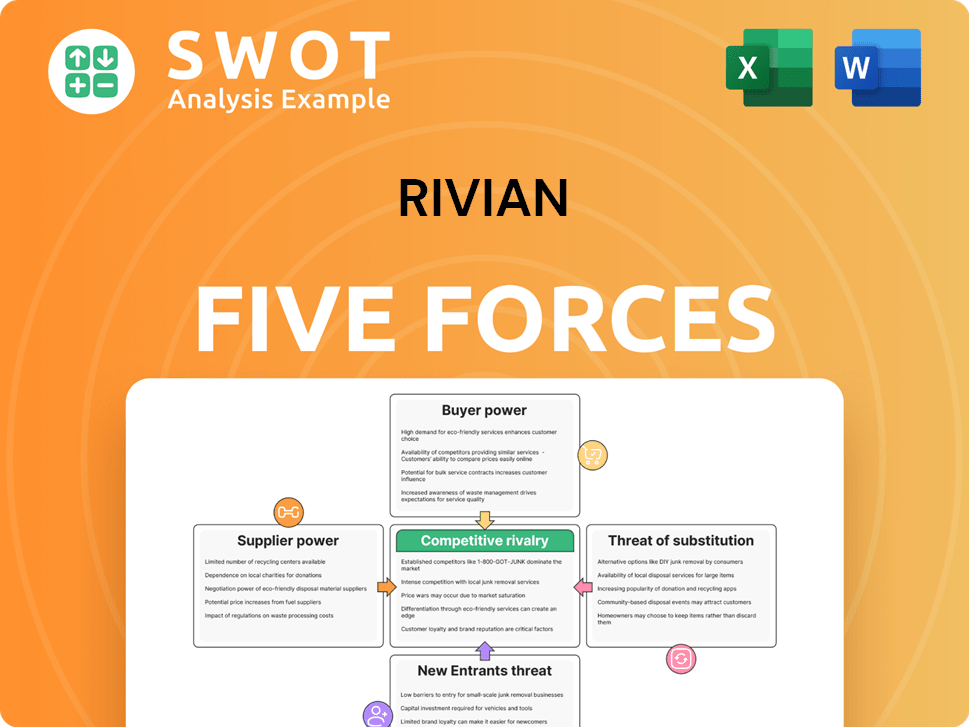
Related Blogs
- What are Mission Vision & Core Values of Rivian Company?
- What is Competitive Landscape of Rivian Company?
- What is Growth Strategy and Future Prospects of Rivian Company?
- How Does Rivian Company Work?
- What is Sales and Marketing Strategy of Rivian Company?
- What is Brief History of Rivian Company?
- Who Owns Rivian Company?
Disclaimer
All information, articles, and product details provided on this website are for general informational and educational purposes only. We do not claim any ownership over, nor do we intend to infringe upon, any trademarks, copyrights, logos, brand names, or other intellectual property mentioned or depicted on this site. Such intellectual property remains the property of its respective owners, and any references here are made solely for identification or informational purposes, without implying any affiliation, endorsement, or partnership.
We make no representations or warranties, express or implied, regarding the accuracy, completeness, or suitability of any content or products presented. Nothing on this website should be construed as legal, tax, investment, financial, medical, or other professional advice. In addition, no part of this site—including articles or product references—constitutes a solicitation, recommendation, endorsement, advertisement, or offer to buy or sell any securities, franchises, or other financial instruments, particularly in jurisdictions where such activity would be unlawful.
All content is of a general nature and may not address the specific circumstances of any individual or entity. It is not a substitute for professional advice or services. Any actions you take based on the information provided here are strictly at your own risk. You accept full responsibility for any decisions or outcomes arising from your use of this website and agree to release us from any liability in connection with your use of, or reliance upon, the content or products found herein.